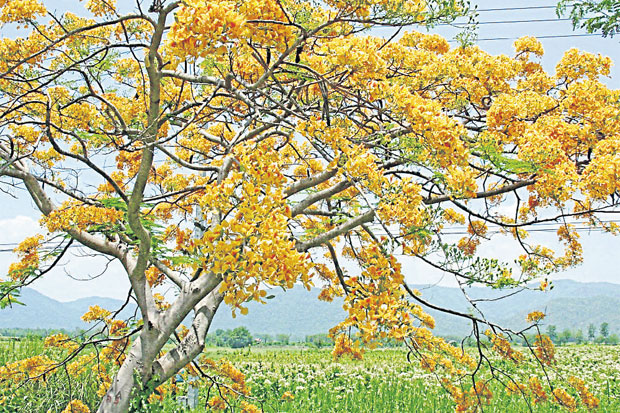Showing 31 - 40 of 236
Xerophytes win water fights
B Magazine, Normita Thongtham, Published on 22/05/2016
» May is almost at an end. Usually around this time, our friends Bantherng and his wife Phen are busy harvesting lychee in their orchard in Phetchabun. This year, however, not one of their more than 100 trees bore fruit. In fact, not one lychee tree in their district of Nam Nao, some 40km from Nam Nao National Park, had fruit this year.
The agony andthe ecstasy
B Magazine, Normita Thongtham, Published on 15/05/2016
» I was ecstatic when I saw fruits hanging for the first time from the branches of my Pouteria campechiana tree, otherwise known as canistel or eggfruit. It is called lamut khamen in Thai but actually few Thais know it, and even fewer have tasted it. I suspect that the first tree grown in Thailand came from the seed of a fruit taken from across the border in Cambodia, and the grower named it "lamut khamen" after the country or its people (khamen is the Thai word for Cambodian), as he did not know its proper name.
Turn over a fresh leaf
B Magazine, Normita Thongtham, Published on 08/05/2016
» If you have tasted the Thai traditional snack mieng kham, then you know how Piper sarmentosum, or cha phlu in Thai, is eaten. Mieng kham is a concoction of one or two pieces of diced ginger, shallots and lime, a slice or two of chilli, one or two pieces of dried shrimp and roasted peanut, and a pinch of toasted shredded coconut. All of that is topped with a sauce made from palm sugar, fish sauce, galangal, lemongrass and ginger, and wrapped together with a cha phlu leaf. Eaten in one bite, the different flavours blend perfectly, like different musical instruments played harmoniously together to create a beautiful melody.
If you can stand the heat
B Magazine, Normita Thongtham, Published on 01/05/2016
» It's especially hot, of course, in Thailand during the summer months. But judging from the way Cassia fistula is blooming heavily this year, this summer has been even hotter than previous years.
What we do in the shadows
B Magazine, Normita Thongtham, Published on 24/04/2016
» Violeta Anselmi likes plants, but the only place she can grow them is her balcony. The problem is that it does not get direct sunlight, for it is shaded most of the time. "Up to now, we have been unsuccessful in keeping our potted plants alive," she wrote.
Passing the smell test
B Magazine, Normita Thongtham, Published on 17/04/2016
» Ten years ago, Kriepob Limkangwalmongkol wrote to say that Phuket, where he lived, had many Chinese Taoist temples and they burned quite a lot of mai juang, or theptaro wood, to cleanse the atmosphere during their numerous ceremonies, especially during the annual vegetarian festival.
Flowers of flame
B Magazine, Normita Thongtham, Published on 10/04/2016
» The Tabebuia rosea, or chompoo panthip, on Kasetsart University's Kamphaeng Saen campus in Nakhon Pathom province caused a traffic jam as it attracted people from far and near last February. The trees were planted on both sides of the road and when they dropped all their leaves, only to be blanketed by flowers all at the same time, they were a sight to behold.
The plants are bugged
B Magazine, Normita Thongtham, Published on 03/04/2016
» There’s a sad footnote to the story about Petchsuporn Rapley’s date palms in Doi Saket, Chiang Mai (Green Fingers, March 6). For those who did not read the article, Ms Petchsuporn planted some 100 date palms as an experiment a little over three years ago. A year later two trees started to flower, followed by a few more last year. Braving sharp-as-nails giant thorns, she and her workers cross-pollinated the trees manually and these successfully bore fruit for the first time last year.
Hedge your bets
B Magazine, Normita Thongtham, Published on 27/03/2016
» Brian Corrigan wants to get away from concrete walls around his Bangkok property and have a more environmentally friendly screen from his neighbours. “I need the plant to grow to around 1.5 metres tall. Can you recommend something, please?” he wrote.
All the small things
B Magazine, Normita Thongtham, Published on 20/03/2016
» Records show that the Japanese have practised the art of bonsai, or cultivating miniature trees in pots and trays, since the 9th century. However, for hundreds of years it remained the preserve of monks and the nobility. It was only at the beginning of the 19th century that it gained popularity at every level of the Japanese society.










